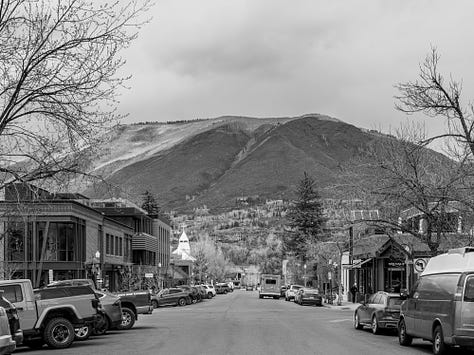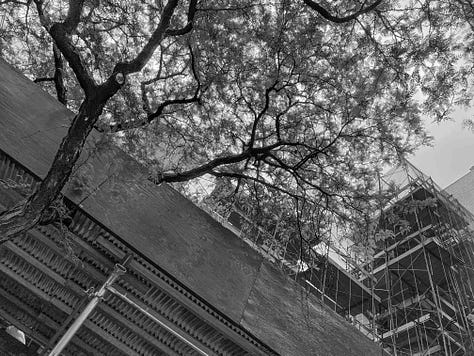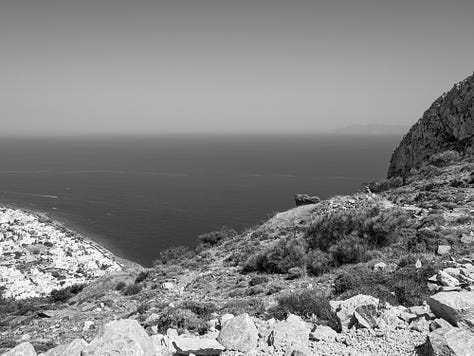We are constantly amazed, inspired, and appreciative of the experience, talent, and dedication of our little Paper Arts community. From time to time we’ve featured some of our members’ work. Today I’d like to feature a project I had the pleasure to experience and provide some help in its progress. I’d love to do this regularly with more of our members’ projects, someday even a festival of print, or quarterly publication. For now, I’ll let the artist speak for herself. Please provide comments and encouragement to Michelle as she’s actively working on ”Concious Entanglements”.
About the Project
This project evolved as I began to realize that for me, photography is a form of visual meditation, allowing me to slow down and contemplate the wild and constructed aspects of our landscape, our entangled relationships with each other, and how they reflect our contemporary condition. Examining spaces in transition, overlooked corners and neglected or uncultivated locations lets me imagine what brought them to their current state, ponder the untold stories embodied within them, and appreciate their beauty and precarity while acknowledging the ongoing tussle between nature and the human quest for progress.









Where it is Now and Where it’s Going
This is an ongoing project, which I can take with me almost anywhere I bring my camera. The layered struggle between humankind and nature is ever-present, and I am always on the lookout for images that embody visible traces of human activity and passivity and remind us that we and the world we live in are interconnected, our choices about how we inhabit it matter, and that at the end of the day, nature is bigger than us all.
In terms of equipment, I use one of two full-frame cameras. The Hasselblad X1D II 50C medium format camera with the XCD 45 lens or the Nikon Z7 II with the Nikkor Z 24-70mm f/2.8 S lens. I like each of them for different reasons. I was looking to graduate from a camera with a cropped sensor to one with a full sensor and a teacher of mine suggested that my work would be suitable for making large prints. At that time, the Hasselblad X1DII 50 C had recently entered the market and was one of the most compact medium format cameras available, and after renting it for a couple of weeks I decided to take the plunge. After a few months, I realized that the absence of in-body image stabilization was becoming an issue for me (I don’t always go out with a tripod) and I also wanted to have some lens flexibility without investing in several Hasselblad lenses. My solution was to try the Nikon Z7II and Nikkor Z 24-70mm f/2.8 (which I had also been considering at the time I decided to get the Hasselblad). No problem with in-body image stabilization in the Nikon, so now I have an alternative that provides me with large files, high resolution, and a variety of focal lengths to choose from when out in the field (though I still should take my tripod along more often regardless of which camera I am using).
Producing the Portfolio
Selecting a limited number of images to create a portfolio representing this ongoing body of work was very challenging. Here’s why: The act of taking a photograph hopefully happens when the eye and the mind are open to possibility and the idea of producing something satisfying on some level. The process of narrowing down a broad group of images into a succinct, persuasive, and compelling selection is another matter. The skills and objectivity required to do this are different from those we use when framing a shot, taking a photograph, and editing it in post-production.
It is difficult for me to be critically objective about my photographs. Working with a small and trusted group of photographers while creating this portfolio was instrumental for me. Guided by Les and Bob, the group became an integrated team. We all took turns examining each other’s work, suggesting which images were stronger than others, reviewed proposed sequencing and offered suggestions, examined paper choices, finished prints, and even shared input on portfolio titles. The result was a professional photography portfolio to be proud of. As I move forward with this and other projects, I will continue to seek out and value the input of trusted persons in my photography community. Their objectivity and the prospect of broadening my perspectives are well worth it.
As for the images that did not make the portfolio “cut” but which I had optimistically included in the broader group to be considered…I hope that in time I can broaden this project into a book or an exhibition. My work isn’t “obvious”…I like to think that it emerges in bits and pieces. I like to find revelatory details that often go unnoticed and to find beauty, harmony, or even disharmony in unexpected places. I imagine that a whole new set of choices and challenges await should a potential book or exhibition opportunity arise, and I look forward to facing them should that occur.





Michelle, it was an honor to be involved in your project(s). Your passion, enthusiasm and critical eye are an inspiration. Please keep up your amazing work!
When I think of "entanglements," I turn to my own philosophy of the object: that in any given circumstance, a thing is but a relation to another thing: it is not discrete. It can't be. Even in portraiture, for example, the sole subject in front of the camera is, so to speak, an entanglement of experiences, hopes, traumas, and unknowns, both conscious and unconscious, and good portraiture unveils, reveals, these intricate warps and woofs, a tapestry of character.
As I'm imagining this project, I can't see how nature and humanity can be discrete, unentangled, since we're not only IN an environment but OF one too. This makes humanity a natural thing, born of nature, and nature, in essence, the laws and structures of what is physically and chemically possible: THE LAW. As with the work of Robert Adams, this project holds, in one sense, to that mission to provoke our conscious alienation of nature and its subjugation to human power and greed, while, in a respective sense, stirring unconscious imbalances in our physical and mental health (not to mention the imminent destruction of our habitat, air, water, etc.)
I hope, in this project, that you continue to unfold the alienating effects of capitalism, this idea that there is an unlimited supply of goods and resources, equally abundant and replenishable, and reveal just how pervasive and undying nature can be, even in the face of extinction and annihilation. You do so (so far) not with disturbing images, but with a quietude, a meditation, on the "creep" of devastation waiting at our fingertips, the simple crack of concrete with a flower busting through. This is the image of nature's pervasiveness.
Good luck. I think we all wish you well. Because it's each and every one of our collective fight.